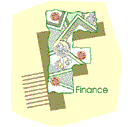Capital budgeting is the process by which the financial manager decides whether to invest in specific capital projects or assets. In some situations, the process may entail in acquiring assets that are completely new to the firm. In other situations, it may mean replacing an existing obsolete asset to maintain efficiency.
 During the capital budgeting process answers to the following questions are sought:
During the capital budgeting process answers to the following questions are sought:
- What projects are good investment opportunities to the firm?
- From this group which assets are the most desirable to acquire?
- How much should the firm invest in each of these assets?
Components of Capital Budgeting
Initial Investment Outlay:
It includes the cash required to acquire the new equipment or build the new plant less any net cash proceeds from the disposal of the replaced equipment. The initial outlay also includes any additional working capital related to the new equipment. Only changes that occur at the beginning of the project are included as part of the initial investment outlay. Any additional working capital needed or no longer needed in a future period is accounted for as a cash outflow or cash inflow during that period.
Net Cash benefits or savings from the operations:
This component is calculated as under:-
(The incremental change in operating revenues minus the incremental change in the operating cost = Incremental net revenue) minus (taxes) plus or minus (changes in the working capital and other adjustments).
Terminal Cash flow:
It includes the net cash generated from the sale of the assets, tax effects from the termination of the asset and the release of net working capital.
The Net Present Value technique:
Although there are several methods used in Capital Budgeting, the Net Present Value technique is more commonly used. Under this method a project with a positive NPV implies that it is worth investing in.
Example:
A company is studying the feasibility of acquiring a new machine. This machine will cost $350,000 and have a useful life of three years after which it will have no salvage value. It is estimated that the machine will generate operating revenues of $300,000 and incur $75,000 in annual operating expenses over the useful life of three years. The project requires an initial investment of $15,000 in working capital which will be recovered at the end of the three years. The firm’s cost of capital is 16%. The firm’s tax rate is 25%.
To simplify the problem, depreciation is not considered.
Solution:
Initial Investment is $350,000
Initial Net Working Capital is $15,000
Present Value of the annual operating cash flow after tax
= ($300,000-$75,000) x (1-0.25) x PVIFA(16%,3years)
= $225,000 x 0.75 x 2.2459
= $378,996
Note: The number 2.2459 can be obtained by using an ordinary calculator. Procedure to be followed:
For Year 1, divide 1 by 1.16 = 0.8621
For Year 2, the calculator screen shows 0.8621, press the = key, you will get 0.7432
For Year 3, the calculator screen shows 0.7432, press the = key, you will get 0.6406
Add up all the three to get 2.2459
Since the asset will not have any salvage value at the end of the third year we need not calculate the Present Value.
Present Value of the net working capital at the end of the project
= $15,000 x PVIFA(16%,3rd year)
= $15,000 x 0.6406
= $9,609
Net Present Value = ($ 350,000) + ($ 15,000) + $ 378,996 + $ 9,609 = $ 23,605
Since the NPV is positive it is feasible to purchase the equipment.